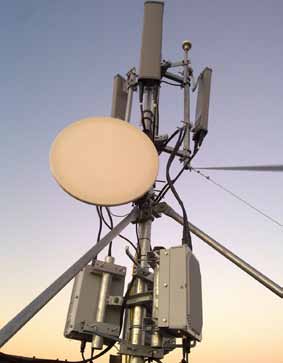Universal mobile Telecommunications system (UMTS): 3G and 3.5G
A cellular technology developed by the 3GPP, UMTS can be considered as the start of real broadband wireless access, with up to 42Mbps speeds achievable in the Indian context. The UMTS standard provides specifications for the whole network, combining three different air interfaces—GSM’s mobile application part (MAP) core and the GSM family of speech codecs. While WCDMA-based UMTS networks are considered 3G, those that use HSPA are often referred to as 3.5G.

WCDMA. The 3G implementations of UMTS use WCDMA to offer greater spectral efficiency and bandwidth to mobile network operators. According to the Wikipedia, WCDMA is a wideband spread-spectrum mobile air interface that utilises the direct sequence spread spectrum method of asynchronous code division multiple access to achieve higher speeds and support more users compared to the implementation of time division multiplexing (TDMA) used by 2G GSM networks. In short, WCDMA improves upon the capabilities of 2G GSM networks. This probably explains why UMTS networks are often described as 3GSM networks. However, UMTS networks require new base stations and new frequency allocations, and do not directly build on the GSM standards like EDGE does.
HSPA. 3GPP’s HSPA is often known as 3.5G, as its mobile telephony protocols extend and improve the performance of WCDMA-based UMTS protocols through more efficient use of the broadband spectrum, and improved protocols and communication rules for the movement of voice and data packets between handheld de-vices and base stations.
HSPA combines two mobile telephony protocols—high-speed downlink packet access (HSDPA) and high-speed uplink packet access (HSUPA). Evolved HSPA (HSPA+) that is being used since 2010 uses the spectrum even more efficiently, allowing for higher peak data rates and fewer delays in data transmission. UMTS network with HSPA+ can easily reach speeds of 42 Mbps on a single 5×2 MHz carrier.
[stextbox id=”info” caption=”BWA networks demystified”]
Shyam Ananthnarayan, vice president – communications and wireless technology business, Tata Elxsi, explains some key features of BWA network infrastructure…
A typical BWA network is usually composed of two key elements—base station and end-user subscriber equipment. The base station is typically realised as an indoor unit that uses outdoor antennas to send and receive high-speed data to and from the end user, and communicates with the core network through a single gateway. This is different from the traditional 2G/3G cellular systems that have been designed in a hierarchical manner with multiple nodes (network elements) to handle both circuit-switched voice and packet-switched data traffic.
Next-generation networks (NGN) such as WiMAX and LTE are based on flat IP architectures to support high-speed data traffic (Refer http://www.heavyreading.com/details.asp?sku_id=2180&skuitem_itemid=1097).
To efficiently deliver mobile broadband services, operators require a network infrastructure that simultaneously provides lower costs, lower latency, and greater flexibility. The key to achieving this goal is the adoption of flat, all-IP network architectures. With the shift to flat IP architectures, mobile operators can:
1. Reduce the number of network elements in the data path to lower operations costs and capital expenditure.
2. Partially decouple the cost of delivering service from the volume of data transmitted to align infrastructure capabilities with emerging application requirements.
3. Minimise system latency and enable applications with a lower tolerance for delay; upcoming latency enhancements on the radio link can also be fully realised.
4. Evolve radio access and packet core networks independently of each other to a greater extent than in the past, creating greater flexibility in network planning and deployment.
5. Develop a flexible core network that can serve as the basis for service innovation across both mobile and generic IP access networks.
6. Create a platform that will enable mobile broadband operators to be competitive, from a price/performance perspective, with wired networks.
7. Another key factor for the wireless network infrastructure setup is the network topology and the installation points for the base stations that serve subscribers/end users. In 4G networks that offer high-speed data services, the network topology is likely to be driven by the data backhaul considerations, keeping the low latency requirements for various applications in mind. Therefore, instead of large macro cells serving thousands of users, we are likely to see smaller micro and pico cells in metropolitan areas, with multiple base stations and outdoor antennas covering an area from just a few hundred metres to a few kilometres.
[/stextbox]
“3G evolution based on HSPA is one approach in the BWA evolution. Today there are more than 330 HSPA-capable mobile broadband networks serving more than 375 million users worldwide. Data rates of several Mbps are generally available and peak data rates as high as 80 Mbps are supported by the latest HSPA specifications. HSPA continues to evolve, and it will remain a highly capable and competitive radio access solution,” remarks Sanjay Dhawan, vice president, Ericsson India.







You could use a standard to determine this.